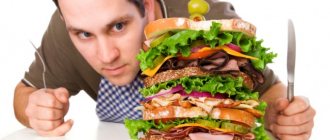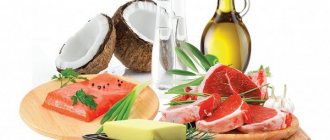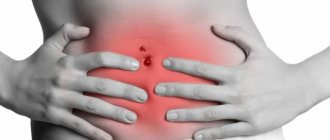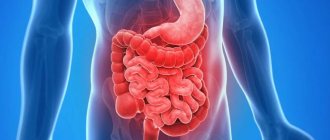Stomach hurts from fatty foods
Abdominal pain after eating fatty foods can create a lot of different inconveniences for a person.
Different types of foods cause different digestive reactions in the body. Eating high-fat foods can cause mild or even severe stomach pain for a variety of reasons.
Some relatively common diseases, such as GERD, may be factors in the development of pain that occurs after consuming fatty foods.
More serious illnesses, such as inflammation of the gallbladder, pancreas or severe intestinal diseases, can also cause discomfort after eating a high-fat meal.
If a person has a stomach ache from fat, it is important to determine the cause of the pain, that is, consult a doctor who will make an accurate diagnosis and prescribe a course of treatment.
Medications
Almagel
Gastal
No-shpa
Spasmalgon
Before taking medications, it is worth remembering that doing anything without a doctor’s prescription and diagnosis is not recommended. But how to treat the stomach if it hurts a lot? In the presence of gastritis or ulcers, effective medications are prescribed that normalize the acidity level and also eliminate pathogenic microflora.
Stomach pain can usually be treated with the following remedies:
- Maalox;
- Methyluracil;
- Phosphalugel;
- Drotaverine;
- No-Shpa.
These are the most common ones listed, but there are many others that you should ask your doctor about. With their help, the stomach is treated without restrictions on certain foods. But it is worth remembering that the importance of diet has been proven and scientifically substantiated, so you should not rely on medications alone. To heal your body, you need to stop eating foods such as:
- Fresh bread and pastries;
- Hot spices;
- Roast;
- Alcohol;
- Tea and coffee;
- Animal fats;
- Chocolate.
It should only be cooked by steaming. Meals prepared in this way will help normalize the functioning of the stomach and improve well-being.
Causes of pain
Gallbladder disease can cause stomach pain after eating fatty foods. The gallbladder produces bile, which helps the body digest and absorb fat.
This organ supplies bile to the intestines after food enters it from the stomach.
Temporary blockage of the bile ducts by stones or thick clots of bile can trigger a gallbladder attack, medically known as biliary colic.
Intense pain in the upper right part of the stomach, which can radiate to the shoulder, occurs precisely because the gallbladder contracts to reduce the “clogging” of the body.
Biliary dyskinesia sometimes follows the ingestion of a high-fat meal, probably due to the strong stimulatory effect of fat on gallbladder contractions.
Pain during dyskinesia that worsens over time or persists for a long period often indicates the progression of acute cholecystitis or an inflammatory process in the gallbladder, which requires immediate treatment after its detection.
Other common symptoms include nausea, vomiting, fever and chills.
Risk factors for gallbladder disease include being female, rapid weight loss, being overweight, being over forty years of age, and a history of gallbladder disease.
Irritable bowel syndrome (IBS) is a well-known functional disorder of the gastrointestinal tract, in which the intestines do not show probable signs of illness, but often function incorrectly and are painful, after which there is a change in the process of bowel movement.
IBS can be diagnosed based on symptoms, which include abdominal pain, increased gas, and nausea.
Although experiments have not been able to conclusively identify specific foods that trigger IBS, people with the condition commonly report that certain foods trigger symptoms of the disease.
Foods and dishes with a high amount of fat in their composition, as well as fried foods, can cause manifestations of IBS in a certain category of people.
Other foods with a high risk of IBS include milk and dairy products, alcoholic beverages, chocolate and coffee.
IBS is more common among females than males. Other risk factors include high levels of psychological stress and cigarette smoking.
Therapy for the syndrome is aimed at reducing the intensity of symptoms, which, first of all, includes following an individual diet and changing lifestyle.
Gastroparesis occurs due to delayed gastric emptying and slow passage of food from the stomach to the small intestine.
It is caused by decreased or absent stomach contractions.
Common symptoms include a feeling of fullness, nausea, heartburn, bloating in the upper abdomen, and stomach pain (which hurts intensely and frequently). Fatty foods may cause or worsen symptoms.
During an exacerbation of the disease, food with a high fat content remains in the stomach longer and provokes further delays in gastric emptying.
People with diabetes, diseases associated with nerve damage, or abdominal diseases have a higher risk of developing gastroparesis.
Taking medications such as tricyclic antidepressants and some painkillers can also cause this condition.
Fatty foods can also weaken the lower esophageal sphincter, which closes when the stomach contracts and prevents stomach contents from refluxing into the esophagus.
Disruption of this process can lead to the reflux of stomach contents into the esophagus, causing heartburn and pain in the upper abdomen.
Although heartburn is common in certain cases after eating fatty foods, persistent heartburn may indicate gastroesophageal reflux disease (GERD), which requires urgent treatment.
Inflammatory bowel diseases include Crohn's disease and ulcerative colitis, diseases that can be characterized by chronic or recurrent inflammation of the gastrointestinal tract, particularly in the intestines.
In the presence of such pathologies, the immune system reacts incorrectly in relation to bacterial agents, food products and other intestinal contents, which leads to inflammation.
The digestive system breaks down light fats into smaller molecules, which pass into the bloodstream. Various conditions can interfere with this process, leading to what is called fat malabsorption.
When people with this condition eat fatty foods, undigested fat in the intestines often leads to abdominal cramps, flatulence, excess gas, and greasy stools or diarrhea.
Some disorders can lead to malabsorption. For example, inflammation of the pancreas (pancreatitis) can lead to fat malabsorption due to a reduction in the production of fat enzymes.
Diseases of the liver and gallbladder, which reduce the formation and secretion of bile, can also interfere with the normal digestion of fats.
Other medical disorders that may lead to fat malabsorption include:
- Inflammatory bowel disease.
- Celiac disease.
- Short bowel syndrome.
- Pancreatic cancer.
- Cystic fibrosis.
Sometimes stomach discomfort after eating fatty foods does not indicate the presence of a serious medical problem, especially if the pain goes away quickly and does not interfere with a person’s life.
At the same time, regular or periodic pain may indicate a possible illness.
A person should see a doctor if they experience any of the anxiety signs or symptoms below:
- Severe, constant abdominal pain.
- Fever, chills, or clammy skin.
- Frequent vomiting mixed with blood.
- Burgundy or resinous stool.
- Dizziness or fainting.
- Chest pain or shortness of breath.
It is important to see a doctor early and get a diagnosis as soon as possible, particularly if the pain is accompanied by other symptoms or weight loss. The doctor will answer the question why your stomach hurts and how to treat it.
Therapy will depend on the main causative factors and may consist of medications, lifestyle changes once a gastrointestinal problem is discovered, and following a proper diet.
Diagnostics
Modern diagnostic measures are at the highest level, which makes it possible to recognize various diseases in the early stages of their appearance.
The causes of stomach pain after eating can be identified using the following options for examining the body:
- Questioning the patient to clarify the nature of the pain after eating, its location and the person’s lifestyle.
- Palpation, during which the doctor tries to palpate the problem area and determine the person’s reaction to touch. It is this procedure that can help identify cholecystitis and pancreatitis.
- Examination of the stomach using a phonendoscope. All people know such a procedure as FGDS. It is one of the most important and effective in diagnosing problems with the gastrointestinal tract. It is endoscopy that makes it possible to see the gastric mucosa and detect an ulcer, tumor or inflamed area.
- Ultrasound diagnostics of internal organs located in the abdominal cavity.
- X-ray examination using a contrast agent.
- Taking an analysis for the presence of Helicobacter bacteria in the body.
Diagnosis becomes significantly more difficult when the pain does not go away and an examination of the stomach does not reveal any pathology. Here doctors must prescribe blood and urine tests, take liver tests, and stool tests.
In addition, it is recommended to do a chest x-ray, electrocardiogram and echocardiogram.
After all these examinations, the doctor will be able to make a final diagnosis, understanding the reasons for the formation of the pathology.
After the doctor listens to the patient’s complaints, he proceeds with a direct examination - palpation of the abdominal organs, auscultation of the heart rhythm, listening to the lungs. Next, he will give a referral for laboratory testing of blood, urine and feces. If necessary, the patient is referred for an abdominal ultrasound or radiograph.
To determine whether stomach pain after eating is the cause of gastrointestinal pathology, you need to undergo several diagnostic measures.
A general blood test will help identify the presence of an inflammatory process, and will also give the doctor more detailed information about your condition. Based on this test, the doctor can recommend more specialized ones - those that will help identify problems in the digestive organs.
FGDS (fibrogastroduodenoscopy) is a study of the condition of the esophagus, stomach and duodenum using a probe with a video camera at the end. This method allows the doctor to look inside the patient, assess the condition of the mucous membrane, and see possible foci of inflammation, ulcers, erosion, and neoplasms.
Usually, during the procedure, a fragment of the mucous membrane is taken for examination. This helps determine the presence of Helicobacter pylori infection and the likelihood of cell degeneration.
Ultrasound of the stomach is another additional method that will help evaluate its functioning.
CT scans and x-rays of the stomach help identify the presence of benign or malignant tumors.
The most common questions at a gastroenterologist’s appointment regarding abdominal pain
Prevention and treatment
Often medications such as antibiotics are used to treat common abdominal pain.
However, if a person experiences abdominal pain after eating fatty foods, it is advisable to consult a doctor to rule out any other health problems, especially if the pain radiates to the stomach and does not subside for a long time.
Preventative measures to prevent abdominal pain are given below. In particular, it is necessary:
- Avoid consuming all fatty foods, as well as unhealthy foods such as packaged foods, fast food and meals with high oil content. It is recommended to make dishes low in fat.
- Try to eat at a set time, take intervals of several hours and take breaks after each meal.
- Do not fall asleep immediately after dinner. Instead, it is advisable to get some fresh air and just take a walk outside to improve digestion.
- Don't overeat. It is recommended to eat healthy foods in small quantities but often
- Drink clean, filtered water and other liquids in moderation after meals.
Why does my stomach hurt?
The pain that occurs after eating is associated with the digestive system and indicates that there is a problem in some organ, but it is not always the stomach. The cause may be the gallbladder, liver, or intestines. Let's look at the common reasons.
The first signs that there was something wrong with the food appear after a few hours. Symptoms of poisoning depend on what was eaten and in what quantity. In addition to abdominal pain, nausea and vomiting, diarrhea, and weakness may occur. In severe cases, the temperature rises. Emergency medical attention is needed if symptoms are severe or if chemical poisoning is suspected.
This is abbreviated as GERD (gastroesophageal reflux disease). Its cause is weakness of the muscular sphincter between the esophagus and stomach. Acid stomach juice enters the esophagus and irritates its mucous membrane.
GERD is more common in obese people and is a concern when overeating or if you lie down after eating. Characteristic signs: heartburn, belching, discomfort when swallowing food.
With it, aching pain appears during meals or immediately after, and intensifies during fasting. Other symptoms: heartburn, belching, unpleasant taste in the mouth, periodic bowel disorders. With gastritis, the patient may complain of general weakness, drowsiness, irritability, and increased sweating during meals.
- Irritable stomach syndrome (IBS)
Most people experience this functional disorder from time to time. In this case, the person is worried about nausea, stomach cramps, flatulence and nagging pain. Food passes through the gastrointestinal tract more slowly or faster than normal, and stool disorders occur. Among the reasons: infections, nervous and hormonal disorders.
This is an inflammation of the pyloric region of the stomach and duodenum, in which the mucous membrane is inflamed and damaged, the motility of the gastrointestinal tract and the production of gastric juice are impaired. Gastroduodenitis is similar to IBS and gastritis in symptoms, but can also occur in an indirect form. There are several forms of the disease, and its consequences can be stomach bleeding and even the development of cancer.
- Stomach and duodenal ulcers
This is a lesion of the mucous membrane, which is manifested by the formation of ulcers due to infection with Helicobacter pylori. Pain from a peptic ulcer can be different in nature. They bother you constantly and are often worse on an empty stomach. They may have a permanent localization - in the left or right side of the abdomen, in the center (depending on where the ulcer formed). Additional symptoms: heartburn, sour belching, nausea after eating.
To digest this milk carbohydrate, our body must produce an enzyme - lactase. With its deficiency or absence, undigested lactose enters the small intestine, where it causes pain, bloating, and upset. You can suspect lactose intolerance by constant abdominal discomfort after drinking milk (less often, other dairy products).
It is characterized by girdling pain that does not go away for several days. It becomes stronger after eating, accompanied by bloating, fever, and nausea.
With them, the stomach hurts in the right hypochondrium, and the pain radiates to the stomach area. More often occurs after smoked, salty, fatty foods.
Too much fat: how to help the body?
Disclaimer
Please note that all information posted on the Prowellness website is provided for informational purposes only and does not constitute a personal program, a direct recommendation for action or medical advice. Do not use these materials for diagnosis, treatment or any medical procedures. Consult your physician before using any method or product. This site is not a specialized medical portal and does not replace professional advice from a specialist. The Site Owner does not bear any liability to any party who has suffered indirect or direct damage as a result of improper use of materials posted on this resource.
Various holidays may be accompanied by an abundance of fatty foods. If you get carried away, you may feel unwell after a while. It is important to properly help the body process fatty foods to minimize harm to the digestive system.
Signs of overeating
The human stomach is capable of stretching under the pressure of food entering it. If more food is consumed, it has a bad effect not only on overall well-being, but also on overall health.
Normal digestion of fatty foods depends on the presence of pancreatic juice and bile working in the lumen of the duodenum. Bile activates lipase, as well as the entire process of processing fatty foods. If a person eats too much fat, a deficiency of bile or lipase occurs. The following symptoms of overeating fatty foods appear:
- heaviness in the stomach;
- bloating;
- nausea;
- after dinner, insomnia begins;
- general lethargy, state of overwork;
- stomach ache;
- in some cases shortness of breath is observed.
At the first manifestations of overeating, it is necessary to take measures to alleviate the condition. There are several methods that will successfully help with this.
Medications
When prescribing a medicine, the doctor takes into account the characteristics of the body. Possible allergic reactions and lack of improvement after taking medications are taken into account and corrected.
Almagel
Suspension intended for oral administration. The action of the medicine is aimed at adsorbing toxins and other substances that poison the body. Once in the stomach, it neutralizes hydrochloric acid and creates an additional protective layer on the walls. Thanks to spreading, it is possible to better distribute medicinal components to damaged areas. The pain goes away within 3-5 minutes.
When taking orally, you must strictly follow the doctor’s recommendations and carefully read the instructions. Prohibited for use by children under 10 years of age and pregnant women.
Gastal
Pharmacological form of release - tablets. This adsorbent acts on the acidity of gastric juice, reducing it. Active substances are aluminum and magnesium. Substances that help neutralize hydrochloric acid and restore normal acid-base balance.
No-shpa
A popular antispasmodic drug. It affects blood vessels, dilating them. Reduces the tone of muscle tissue of organs. Does not affect the human nervous system. Stops hurting 3-5 minutes after taking it.
Spasmalgon
Stomach pain after fatty foods treatment
Surely many people are familiar with the unpleasant sensations after a hearty, hearty meal with a lot of butter or fatty sauces. Fats are not an absolute evil; our body needs them. However, even a slight excess of fat in food can lead to heartburn, pain and a feeling of heaviness in the stomach. Why does this happen, what foods should you avoid, and how to deal with the symptoms of dyspepsia, diarrhea, and flatulence after eating fatty foods?
What about fatty foods?
Fats are found in almost all food products: meat, fish, milk, cereals, and minimally even in some vegetables and fruits. Products with the highest fat content include lard and bacon, butter and vegetable oils, nuts, sausages, cheese, cream, and chocolate. They should be consumed in doses. For example, 70 grams of lard (which is just a few small slices) completely covers the daily fat requirement of an adult. But, in addition to this tiny portion of fat, a person will definitely eat other foods containing fats, and as a result, by the end of the day the norm will be exceeded two to three times.
Some products look very healthy and dietary, but don’t be fooled: they are also very high in fat. They are invisible and almost imperceptible to the taste, which creates the illusion of “lightness”. Products with such “surprises” include doctor’s sausage (it consists of one-third fat), light mayonnaise, which contains up to 40% fat, as well as popcorn and corn flakes, crackers, any frozen breaded semi-finished products, cookies, cottage cheese and yogurts , many sauces - in particular, mustard and ketchup.
Nutritionists advise consuming one gram of fat per kilogram of body weight per day. On average, about a third of calories should come from fatty foods. Lack of fat affects your appearance: the skin becomes dry, and hair and nails become weak and brittle. The endocrine system (especially in women), the heart and blood vessels, and cognitive functions are affected. But you shouldn’t get carried away with fatty foods: an excess of fats is even more dangerous than a lack of them.
Fatty acids: benefit or harm?
So, we have already said that both doctors and nutritionists agree: fats are healthy, but not all. However, you should understand this issue in a little more detail in order to distinguish between different types of fats.
Fatty acids are saturated and unsaturated. Their molecular structure is different and they affect the body differently.
Saturated fatty acids are found in cheese, meat, butter and some vegetable oils - palm, coconut. If you abuse this type of fat, there is a risk of developing problems with blood vessels, inflammation, cholesterol levels may increase and metabolism may be disrupted.
Note: The statement that “good” fats do not make you gain weight is a myth. Without exception, all fats are very high in calories, and excess calories from olive oil are stored on the sides in the same way as excess calories from bacon and sausage.
Unsaturated fatty acids are part of the healthy fats found in fish and most vegetable oils, nuts and beans. These fats are necessary for the body: they maintain the integrity of cell membranes, help the functioning of the endocrine system, improve the strength and elasticity of blood vessels, and are involved in the regulation of metabolism and hematopoiesis. In a word, they are vital, but unsaturated fatty acids are not produced in the human body; they can only be supplied with food.
However, this type can also bring problems: an excess of unsaturated acids increases the risk of kidney and liver diseases.
Why do you feel nauseous and have a stomach ache after fatty foods?
You've probably noticed that sometimes after a fatty meal you experience unpleasant sensations: pain, nausea, heartburn, belching. Why does this happen and what does it mean?
The first cause of pain and nausea is overeating itself. The volume of the stomach is small - half a liter when empty. Assess the volume of what you eat: if the portion is larger than a small bottle of mineral water, you have eaten more than you should. But the reason for the discomfort lies not only in the mechanical stretching of the stomach. To digest food, our body produces enzymes. However, if you eat too much, there simply aren't enough enzymes and digestion slows down. Under such conditions, the liver is forced to work at its limit in order to secrete as much bile as possible. Because of this, we feel heaviness in the stomach and nausea, stomach pain and other digestive disorders.
However, you don’t have to overeat to feel unwell. Fatty foods in themselves are a difficult test for the digestive system. Fats are digested very slowly, stay in the stomach for too long and cause irritation of the mucous membrane, which leads to heartburn. And if you drink alcohol with your food, the irritation will only increase.
Why does it hurt
Based on the intensity of pain attacks, doctors can judge the presence of a particular disease. For example, chronic gastritis is always accompanied by aching pain and heaviness that occurs after eating. Burning, unbearable pain indicates increased acidity and activity of hydrochloric acid of the mucous membranes. Constant acute pain syndrome usually occurs with acute pancreatitis, cholecystitis or colitis. Chronic ulcers are characterized by cramping attacks, and when the ulcer perforates, this syndrome develops into severe pain.
After meal
With almost 100% certainty, doctors can declare chronic or acute gastritis if sharp pain in the stomach appears after eating. For example, in the presence of an ulcer, such a symptom does not occur immediately, but half an hour after eating. Gastritis with high acidity is accompanied by heartburn, belching, and possible constipation. Low acidity is characterized by nausea, loss of appetite, rumbling in the stomach, and diarrhea. The causes of such inflammatory processes can be:
- smoking;
- eating spicy, salty or fatty foods;
- improper diet;
- nervous shock and frequent stress;
- physical exercise;
- alcohol abuse;
- taking certain types of medications.
Acute pain
It appears suddenly, like a strong spasm, passes just as quickly, and after a while returns with renewed vigor. It is almost impossible to independently determine the root cause, because the list of problems is very wide. Provokes the occurrence of such discomfort:
- poisoning of the body with toxins, poisons or chemicals;
- diseases of other internal organs - inflammatory processes, exacerbation of chronic pathology;
- infectious diseases;
- psychoemotional disorders;
- exacerbation of stomach ulcers;
- gastroenteritis;
- appendicitis;
- food poisoning;
- exacerbation of chronic gastrointestinal diseases;
- individual intolerance to certain types of foods.
Aching
A pressing sensation is a direct symptom of pyloric stenosis, and if the sensation increases over time, the gastroenterologist may suspect inflammation of the pancreas. In addition, polyps can cause aching and dull pain - a very rare occurrence. You can suspect its presence if pain occurs when pressing on the stomach, sometimes you experience nausea or vomiting of stomach contents.
Night stomach pain
There are no fewer reasons that provoke discomfort in adults during sleep, but almost all of them are associated with problems of the digestive tract or dysfunction of the stomach. These symptoms may occur due to:
- Increased acidity of gastric contents - as a rule, symptoms begin to appear in the morning.
- Diseases that worsen during the movement of internal organs. The lying position and constant rotation of the body during sleep change the position of the stomach, as a result of which it can put pressure on other internal organs.
- Slow peristalsis. It occurs due to the presence of toxins and chemicals and pathogenic microorganisms in the intestines.
Heaviness and pain
Such symptoms often occur in the presence of gastritis with low acidity. In addition to stomach pain after eating, the disease is accompanied by belching, heaviness, nausea, and bloating. These same signs may be associated with partial reflux of stomach acid into the esophagus and disruption of the sphincter. This condition is characterized by precise localization of pain in the epigastric region.
Pressing
This symptom is a frequent companion when overeating, especially if you eat at night. In addition, severe pain in the stomach can signal a violation of food digestion and a lack of liver enzymes, appear after excessive physical exertion, which is associated with severe overstrain of the muscles of the anterior abdominal wall. If the localization of the symptom is the upper part of the stomach, then the causes are tobacco or alcohol abuse.
Paroxysmal pain
Spasmodic symptoms may be caused by a viral or bacterial infection. This disease is called intestinal flu or viral gastroenteritis. This pathology is characterized by fever, diarrhea, and vomiting. Sometimes cramping attacks can be a side effect of sore throat, bronchitis or pneumonia. In this case, the discomfort goes away as soon as the patient gets rid of the underlying disease.











